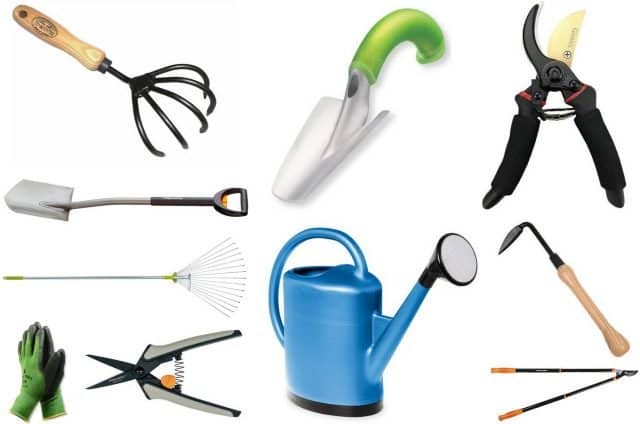
Depending on the complexity of your garden, you’ll want a variety of tools to complete the job. A few hand tools will suffice if you only have a few potted plants. However, if you’ve established an entire garden with rows of plants that you intend to harvest in the fall, you’re going to need some more sturdy tools.
11 Fundamental Garden Tools And Their Intended Uses
Leaf Blower:
Physical aches associated with post-cleaning are minimized when backpack leaf blowers are used. It will alleviate any hand and leg aches and pains. It works similarly to a vacuum cleaner and makes cleaning enjoyable.
Additionally, you will clean spots that a broom or shovel would ordinarily miss. In the garden, backpack leaf blowers are a motorized bag-like piece of equipment that uses compressed air to blast leaves and other garden debris.
Spade:
A spade is the instrument of choice for jobs that are too large for your trowel. A spade is a short-handled shovel that is frequently constructed with a rectangular blade and a perpendicular “D” handle for added grip while digging.
In comparison to a pointed, bowl-shaped shovel, which is great for digging and breaking up soil, a spade is better for slicing through tenacious roots and moving loose soil.
Trowel:
A trowel will undoubtedly be one of the most often used and critical equipment in your arsenal. It’s simply a handheld shovel that you’ll use to move soil, dig, pull weeds, and combine fertilizer, among other things.
Garden trowels are available in an array of forms and sizes and are often constructed using a combination of plastic or wood handles and stainless steel.
Bow Rake:
Rakes are not merely for leaf collection.
A bow rake can be used to collect or clear loose waste in your garden, and they are frequently constructed of stronger steel than a leaf rake. This enables them to perform light tilling, weeding, soil leveling, and spreading loose material such as mulch.
Hand Rake:
If you’re working in a tiny area and are concerned about causing damage to existing plants, you generally won’t want to break out the giant rake for a small job. This would be accomplished using a hand rake.
Hand rakes, like their larger siblings, come in a variety of shapes and sizes and are used for similar tasks on a smaller scale. There are light duty hand rakes with flexible tines available for collecting or clearing debris. However, heavy-duty steel hand rakes with stiff tines for breaking up soil and minor tilling are also available.
Hoe:
A hoe is a time-honored horticultural equipment. There are several varieties, but the most common is the draw hoe, which features a flat blade at the end of a generally wooden handle.
Because the blade is perpendicular to the handle, it is ideal for moving and shaping soil as well as weeding. Hoes can also be used to dig narrow and shallow planting trenches.
Pruning or Garden Shears:
Certain plants require pruning. You’ll need pruning shears for this work, which are essentially scissors on steroids. Additionally known as secateurs, they are used to cut small branches and twigs up to an inch (2.5 cm) in diameter.
Garden shears, which are a step up from pruning shears, can also be used for some lightweight operations that require a lot of cutting. It is a two-handed instrument that is frequently used for hedge trimming.
Weed Puller:
The days of spending hours on your hands and knees removing annoying weeds from your garden are over. While several tools in your armory can assist you in weeding your garden, few instruments perform as effectively as one developed expressly to pull weeds.
Weed pullers exist in a variety of forms, but the basic concept remains the same: entangle the weed in the teeth, twist or clamp, and then pull. Additionally, some weed pullers include a leverage bar that allows you to pull the weeds out at an angle. In theory, the weed should be completely eliminated from the soil, roots and all.
Dandelion Digger:
A fully functional weed puller is ideal for eliminating large quantities of large weeds. However, if you have little weeds growing within your plants, you’ll require a more finesse instrument. You’ll need a handheld weed puller for this, which is frequently referred to as a dandelion digger.
Handheld weed pullers operate similarly to their larger brothers, tangling the weed and roots in their teeth in order to (ideally) remove the entire weed, roots and all. Typically, dandelion diggers resemble a long flathead screwdriver with the end split to aid with entanglement of the weeds. It should be pushed down alongside the weed, twisted, then pulled.
Bow Saw:
You’ll need a bow saw for anything larger than your loppers can handle. It’s essentially a hand saw with extra coarse teeth that should easily sever branches up to 6 inches (15 cm) in diameter.
Loppers:
You’ll require loppers in your arsenal for heavier-duty cutting. Loppers have similar blade styles to pruning shears but have longer handles for increased leverage. Not only will the longer handles enable you to cut through thicker branches, but they will also let you reach deeper without the use of a step stool or ladder.
——————————————————————————————————————–
Author Bio: Elijah Thomas
Elijah Thomas is the Head of SEM at Schroder, He has many years of digital marketing experience and is highly sought-after for his ability to increase awareness for companies. Schroder aims to produce power tools for multiple hobby applications and professional tasks. We want to give users high-performance power tools in a size that is never before seen. Elijah’s goal is to bring this idea to the masses. No matter the State or geography, know that Schroder is by your side tackling whatever job you need.